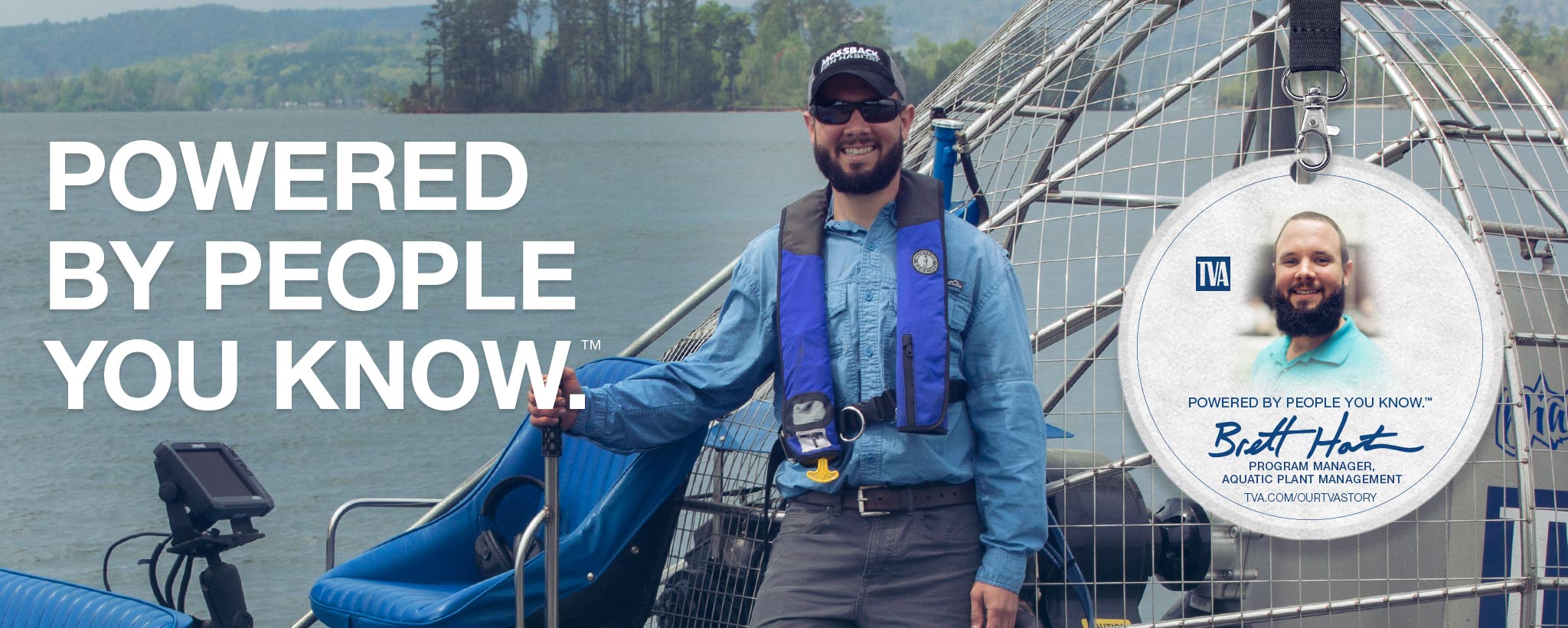Brett Hartis
Program Manager, Aquatic Plant Management | Guntersville, Ala.
I’m an outdoorsman who loves bass fishing, bow hunting and hiking. I’m most comfortable on a boat. I’m an everyday person enjoying life in the Valley with my family. I’m thankful to have a job I’m passionate about that really makes a difference for the people of the Valley.”
“In general, bass anglers love aquatic plants and homeowners and marina operators hate them,” Hartis says, pointing to the heart of what is a complex issue. “It’s easy to see both sides. Aquatic plants provide essential food and cover for bass and other fish. But, on the downside, they’re smelly, messy and capable of completely blocking access to deeper water if they get thick enough.”
The issue is complicated by the fact that some TVA-managed reservoirs have been invaded by non-native plant species such as hydrilla and milfoil—species that can spread like wildfire because they have no native enemies or diseases to keep their populations in check.
“Unmanaged, these plants can cause all sorts of problems,” explains Hartis. “Both hydrilla and milfoil can outcompete more beneficial native vegetation and produce nearly impenetrable mats that impede all recreational activities including fishing access.”
That leaves Hartis with a formidable challenge: to manage aquatic plant populations in TVA reservoirs in a way that optimizes recreation benefits for all reservoir users while protecting long-term reservoir health and species diversity.
“Aquatic plant management varies by reservoir,” he says, “but it generally involves targeted application of EPA-approved aquatic herbicides around developed public shoreline and mowing strips of vegetation to provide access lanes to deeper water.”
A Man on the Go
Summers are hectic for Hartis. From late April through September, he’s on an airboat about five days a week. “I spend a lot of time surveying aquatic plant populations, particularly on Guntersville where we do the most treatment,” he says. “We also do aerial surveys. Survey information helps us identify when and where we need to work and evaluate how well we are doing. Some species grow so fast that we need to go back out 3 to 5 times during the summer.”
He points to hydrilla, known as the kudzu of the water. “It can grow up to four inches per stem per day,” Hartis says.
Education and outreach is a priority for Hartis year-round. “One of the things I like best about my job is the chance it gives me to talk with reservoir users—to help them understand both the good and the bad in terms of how aquatic plants impact their lake. People stop me at boat ramps all the time and ask me questions, and that gives me the chance to clear up some misunderstandings.
“I try to show them I’m an ordinary person—a person who understands their concerns and cares about their lake—not someone who sits in an office all day.”
Hartis couldn’t be better suited for the job. He has the credentials—a Ph.D. in fisheries, wildlife and conservation Biology from North Carolina State University. But it’s his people skills that matter most, he says. “Every day I have the chance to talk to people with different interests, from different walks of life and at different education levels. I like that.”
Hartis also likes being outside. He’s a bass fisherman himself and loves to hunt. “I don’t do well in enclosed places for long periods of time,” he laughs.
Hartis and his wife, Tara, enjoy camping and hiking. They have one son, Trait, who will turn two in June. “He’s starting to get into all the typical boy stuff,” Hartis says. “He loves rocks and dirt and seems to enjoy stomping around outside just as much as I do.”
Want to learn more about Brett Hartis’ work? See the Angler's Aquatic Plant ID.
Meet More People You Know
Meet more TVA employees, and learn about some of the fascinating ways they serve the Tennessee Valley through their work in energy, environmental stewardship and economic development.
They’re your friends, your family, your neighbors. Get to know them.
